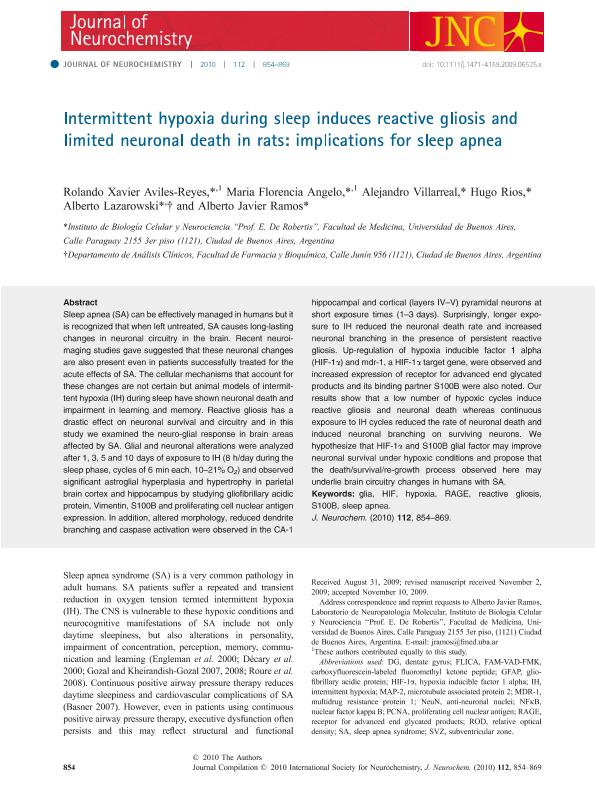Mostrar el registro sencillo del ítem
dc.contributor.author
Aviles Reyes, Rolando Xavier

dc.contributor.author
Angelo, María Florencia

dc.contributor.author
Villarreal, Alejandro

dc.contributor.author
Rios, Hugo

dc.contributor.author
Lazarowski, Alberto Jorge

dc.contributor.author
Ramos, Alberto Javier

dc.date.available
2023-04-10T17:59:13Z
dc.date.issued
2010-02
dc.identifier.citation
Aviles Reyes, Rolando Xavier; Angelo, María Florencia; Villarreal, Alejandro; Rios, Hugo; Lazarowski, Alberto Jorge; et al.; Intermittent hypoxia during sleep induces reactive gliosis and limited neuronal death in rats: Implications for sleep apnea; Wiley Blackwell Publishing, Inc; Journal of Neurochemistry; 112; 4; 2-2010; 854-869
dc.identifier.issn
0022-3042
dc.identifier.uri
http://hdl.handle.net/11336/193098
dc.description.abstract
Sleep apnea (SA) can be effectively managed in humans but it is recognized that when left untreated, SA causes long-lasting changes in neuronal circuitry in the brain. Recent neuroimaging studies gave suggested that these neuronal changes are also present even in patients successfully treated for the acute effects of SA. The cellular mechanisms that account for these changes are not certain but animal models of intermittent hypoxia (IH) during sleep have shown neuronal death and impairment in learning and memory. Reactive gliosis has a drastic effect on neuronal survival and circuitry and in this study we examined the neuro-glial response in brain areas affected by SA. Glial and neuronal alterations were analyzed after 1, 3, 5 and 10 days of exposure to IH (8 h/day during the sleep phase, cycles of 6 min each, 10-21% O2) and observed significant astroglial hyperplasia and hypertrophy in parietal brain cortex and hippocampus by studying gliofibrillary acidic protein, Vimentin, S100B and proliferating cell nuclear antigen expression. In addition, altered morphology, reduced dendrite branching and caspase activation were observed in the CA-1 hippocampal and cortical (layers IV-V) pyramidal neurons at short exposure times (1-3 days). Surprisingly, longer exposure to IH reduced the neuronal death rate and increased neuronal branching in the presence of persistent reactive gliosis. Up-regulation of hypoxia inducible factor 1 alpha (HIF-1α) and mdr-1, a HIF-1α target gene, were observed and increased expression of receptor for advanced end glycated products and its binding partner S100B were also noted. Our results show that a low number of hypoxic cycles induce reactive gliosis and neuronal death whereas continuous exposure to IH cycles reduced the rate of neuronal death and induced neuronal branching on surviving neurons. We hypothesize that HIF-1α and S100B glial factor may improve neuronal survival under hypoxic conditions and propose that the death/survival/re-growth process observed here may underlie brain circuitry changes in humans with SA.
dc.format
application/pdf
dc.language.iso
eng
dc.publisher
Wiley Blackwell Publishing, Inc

dc.rights
info:eu-repo/semantics/openAccess
dc.rights.uri
https://creativecommons.org/licenses/by-nc-sa/2.5/ar/
dc.subject
GLIA
dc.subject
HIF
dc.subject
HYPOXIA
dc.subject
RAGE
dc.subject
REACTIVE GLIOSIS
dc.subject
S100B
dc.subject
SLEEP APNEA
dc.subject.classification
Otras Ciencias Médicas

dc.subject.classification
Otras Ciencias Médicas

dc.subject.classification
CIENCIAS MÉDICAS Y DE LA SALUD

dc.title
Intermittent hypoxia during sleep induces reactive gliosis and limited neuronal death in rats: Implications for sleep apnea
dc.type
info:eu-repo/semantics/article
dc.type
info:ar-repo/semantics/artículo
dc.type
info:eu-repo/semantics/publishedVersion
dc.date.updated
2023-04-04T12:04:38Z
dc.journal.volume
112
dc.journal.number
4
dc.journal.pagination
854-869
dc.journal.pais
Reino Unido

dc.journal.ciudad
Londres
dc.description.fil
Fil: Aviles Reyes, Rolando Xavier. Consejo Nacional de Investigaciones Científicas y Técnicas. Oficina de Coordinación Administrativa Houssay. Instituto de Biología Celular y Neurociencia "Prof. Eduardo de Robertis". Universidad de Buenos Aires. Facultad de Medicina. Instituto de Biología Celular y Neurociencia; Argentina
dc.description.fil
Fil: Angelo, María Florencia. Consejo Nacional de Investigaciones Científicas y Técnicas. Oficina de Coordinación Administrativa Houssay. Instituto de Biología Celular y Neurociencia "Prof. Eduardo de Robertis". Universidad de Buenos Aires. Facultad de Medicina. Instituto de Biología Celular y Neurociencia; Argentina
dc.description.fil
Fil: Villarreal, Alejandro. Consejo Nacional de Investigaciones Científicas y Técnicas. Oficina de Coordinación Administrativa Houssay. Instituto de Biología Celular y Neurociencia "Prof. Eduardo de Robertis". Universidad de Buenos Aires. Facultad de Medicina. Instituto de Biología Celular y Neurociencia; Argentina
dc.description.fil
Fil: Rios, Hugo. Consejo Nacional de Investigaciones Científicas y Técnicas. Oficina de Coordinación Administrativa Houssay. Instituto de Biología Celular y Neurociencia "Prof. Eduardo de Robertis". Universidad de Buenos Aires. Facultad de Medicina. Instituto de Biología Celular y Neurociencia; Argentina
dc.description.fil
Fil: Lazarowski, Alberto Jorge. Consejo Nacional de Investigaciones Científicas y Técnicas. Oficina de Coordinación Administrativa Houssay. Instituto de Biología Celular y Neurociencia "Prof. Eduardo de Robertis". Universidad de Buenos Aires. Facultad de Medicina. Instituto de Biología Celular y Neurociencia; Argentina
dc.description.fil
Fil: Ramos, Alberto Javier. Consejo Nacional de Investigaciones Científicas y Técnicas. Oficina de Coordinación Administrativa Houssay. Instituto de Biología Celular y Neurociencia "Prof. Eduardo de Robertis". Universidad de Buenos Aires. Facultad de Medicina. Instituto de Biología Celular y Neurociencia; Argentina
dc.journal.title
Journal of Neurochemistry

dc.relation.alternativeid
info:eu-repo/semantics/altIdentifier/doi/http://dx.doi.org/10.1111/j.1471-4159.2009.06535.x
Archivos asociados
